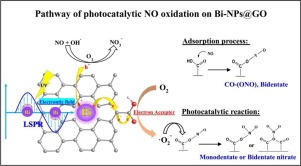当前位置:
X-MOL 学术
›
Appl. Catal. B Environ. Energy
›
论文详情
Our official English website, www.x-mol.net, welcomes your
feedback! (Note: you will need to create a separate account there.)
Bismuth Spheres Assembled on Graphene Oxide: Directional Charge Transfer Enhances Plasmonic Photocatalysis and In Situ DRIFTS Studies
Applied Catalysis B: Environment and Energy ( IF 20.2 ) Pub Date : 2017-09-20 , DOI: 10.1016/j.apcatb.2017.09.046 Xinwei Li , Wendong Zhang , Wen Cui , Yanjuan Sun , Guangming Jiang , Yuxin Zhang , Hongwei Huang , Fan Dong
Applied Catalysis B: Environment and Energy ( IF 20.2 ) Pub Date : 2017-09-20 , DOI: 10.1016/j.apcatb.2017.09.046 Xinwei Li , Wendong Zhang , Wen Cui , Yanjuan Sun , Guangming Jiang , Yuxin Zhang , Hongwei Huang , Fan Dong

|
This work reports a facile approach to monodisperse bismuth nanospheres (Bi-NPs), which are then evenly assembled on graphene oxide (GO) via a solution-based sonication method. The resultant Bi-NPs@GO composite can serve as a robust direct plasmonic photocatalyst to remove 42.3% of ppb-level NO from a continuous flow under UV illumination. Localized surface plasmon resonance (LSPR) of Bi nanospheres were confirmed by a numerical simulations and the intense LSPR on Bi nanospheres under UV illumination accounts for the generation of energetic hot electron/hole pairs for NO removal. Experimental results combined with the density functional theory calculation analysis indicate that the abundant carboxyl groups on GO play crucial roles in whole photocatalysis: (i) form a directional carrier deliver channel: Bi → Cgraphene → CCOOH → OCOOH, facilitating the hot electrons transfer from the plasmonic Bi nanospheres to carboxyl groups and encouraging the carrier separation efficiency, (ii) enrich the reactant concentrations (O2 and NO) around catalyst surface by adsorption, promoting the generation of active radicals O2− and the sequent oxidation of NO. Further examination of the photocatalytic NO oxidation by in situ DRIFT confirms the key roles of carboxyl groups as adsorption/reaction centers for photocatalytic NO oxidation, as well as the pathway of NO oxidation to nontoxic nitrate on the catalyst.
中文翻译:

氧化石墨烯上组装的铋球:定向电荷转移增强了等离子光催化和原位DRIFTS研究
这项工作报告了一种简便的方法,用于单分散铋纳米球(Bi-NPs),然后通过基于溶液的超声处理方法将其均匀地组装在氧化石墨烯(GO)上。所得的Bi-NPs @ GO复合材料可以用作坚固的直接等离激元光催化剂,以在紫外线照射下从连续流中去除42.3%的ppb级NO。通过数值模拟证实了Bi纳米球的局部表面等离振子共振(LSPR),并且在UV照明下Bi纳米球上的强LSPR导致了用于去除NO的高能热电子/空穴对的产生。实验结果与密度泛函理论计算分析相结合表明,GO上丰富的羧基在整个光催化中起着关键作用:(i)形成定向载流子传递通道:Bi→C石墨烯 →C COOH →O COOH,促进热电子从等离激元Bi纳米球转移到羧基并提高载流子分离效率,(ii)通过吸附富集催化剂表面附近的反应物浓度(O 2和NO),促进生成活性自由基Ò 2 -和NO的相继式氧化。原位DRIFT对光催化NO氧化的进一步检查证实了羧基作为光催化NO氧化的吸附/反应中心的关键作用,以及NO氧化为催化剂上无毒硝酸盐的途径。
更新日期:2017-09-20
中文翻译:

氧化石墨烯上组装的铋球:定向电荷转移增强了等离子光催化和原位DRIFTS研究
这项工作报告了一种简便的方法,用于单分散铋纳米球(Bi-NPs),然后通过基于溶液的超声处理方法将其均匀地组装在氧化石墨烯(GO)上。所得的Bi-NPs @ GO复合材料可以用作坚固的直接等离激元光催化剂,以在紫外线照射下从连续流中去除42.3%的ppb级NO。通过数值模拟证实了Bi纳米球的局部表面等离振子共振(LSPR),并且在UV照明下Bi纳米球上的强LSPR导致了用于去除NO的高能热电子/空穴对的产生。实验结果与密度泛函理论计算分析相结合表明,GO上丰富的羧基在整个光催化中起着关键作用:(i)形成定向载流子传递通道:Bi→C石墨烯 →C COOH →O COOH,促进热电子从等离激元Bi纳米球转移到羧基并提高载流子分离效率,(ii)通过吸附富集催化剂表面附近的反应物浓度(O 2和NO),促进生成活性自由基Ò 2 -和NO的相继式氧化。原位DRIFT对光催化NO氧化的进一步检查证实了羧基作为光催化NO氧化的吸附/反应中心的关键作用,以及NO氧化为催化剂上无毒硝酸盐的途径。










































 京公网安备 11010802027423号
京公网安备 11010802027423号